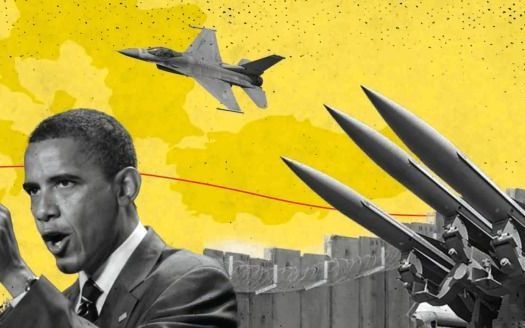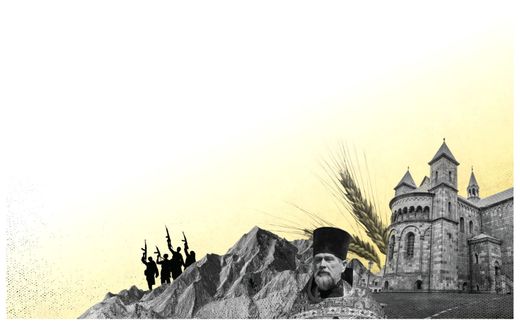Playing bluff at the highest level (part 4/6)
16-04-2022
Opinion
Jakob Hoekman, RD

Illustration RD, Corné van der Horst
Opinion
“If you do this, then that will follow. You have been warned." Anyone who has children will know the temptation. Draw a red line that must not be crossed. And threaten with serious consequences if it does happen.
But what if the child actually crosses the line? Drawing that red line was primarily intended as a deterrent. To really stand firm, that goes a long way.
That is the problem of red lines in international politics in a nutshell. Whoever draws them comes across as a politician who knows what he wants, who is not mocked. That's why red lines sometimes work so well.
Until the other party doesn't care about those firm words. Then it will become clear whether the red line was intended for the stage, or whether it was serious.
There are cases where you would rather not let it come to that. That is why, despite pressure, President Biden is deliberately staying away from drawing a red line in the conflict between Russia and Ukraine. Because he knows that he can then be forced to act in a way that he himself would rather not want.
But what if Russia uses chemical weapons? Or other weapons of mass destruction? "We will respond," Biden's diplomatic reply. But how, he wisely leaves that in the middle. Although, wisely? Biden sometimes makes clumsy statements, such as his suggestion that Putin should be replaced.
But a red line was not. There is only one hard red line in this conflict from a Western perspective, and that is when Russia would cross a NATO border. And from a Russian perspective, there is only one: that Ukraine should not become a NATO member.
Failed border
Many people agree with Biden in his cautious stance. Whoever draws red lines all the time runs the risk of being exposed as a bluff if he cannot enforce compliance. "We have learned our lesson," a senior US official told ABC News last week.
The official referred to the greatest Red Line debacle in recent history: the failed border Obama tried to set in Syria. Obama said in 2012 that the use of chemical weapons in Syria would be one such red line. Whoever crossed that line would face American reprisals.
But not. Because when there was indeed a gas attack in the Ghouta neighbourhood of Damascus in 2013, which killed hundreds of civilians, there was no American response. The US missiles ready to be launched at Syrian targets were cancelled at the last minute. The reason: Obama feared that the consequences of a US response would be worse than the response itself.
Then vice-president Biden had warned Obama like this: big countries don't bluff. But it was already too late. The red-line drama set the tone for Obama's policy in the Middle East. Obama played bluff poker at the highest level, but he lost.
There are experts who argue that Obama's refusal to intervene in Syria even provided significant encouragement for Putin to further expand his power – in Syria, but also in Ukraine. Because you don't have to take the bluffer that is unmasked so seriously anymore.
Nuclear weapon
Bluff often plays a role in defining and maintaining those red lines, states American author David Andelman. He should know, because last year he published his book “A Red Line in the Sand”. To do this, he delved into the history of wars and conflicts and the associated red lines. According to him, there are more red lines in geopolitics today than at any time in world history. His –conservative– estimate comes to at least forty worldwide red lines that the opposing party may not cross by military means and which can often be identified literally.
Take the border between North and South Korea, the wall between Israel and the West Bank, and in Europe the one between Cyprus and Turkish-occupied Northern Cyprus. Or invisible red lines, such as the border that Israeli Prime Minister Netanyahu drew towards Iran. He threatened military action as soon as a nuclear weapon came within reach of Iran.
And then of course there is Ukraine, with two red lines. The first is NATO's outer border: crossing it will bring you the strongest military alliance in the world. The second comes from Putin: Ukraine should not join NATO. He already drew that line in 2007 in a speech in Munich. That the red line is not a bluff has become painfully clear today in Kiev and Mariupol and other cities over which the Russian war machine thunders.
It's up to NATO armies to show that their red line isn't a bluff either. The problem for the defender is that the challenger often doesn't cross the red line in one go. He first tests the resistance, as Hitler did for example in 1938. First, he swallowed Sudetenland, then Czechoslovakia, but England and France let him go. After that, Hitler felt free enough to invade Poland as well.
Putin also tested the resistance: in 2014 he first invaded the Crimean Peninsula. No significant reprisals followed, which strengthened his resolve to invade the rest of the country.
The massive reaction on that must have taken him by surprise. It will undoubtedly make him careful not to cross the real red line: attacking NATO countries like the Baltic states. To date, none of the successive Russian presidents has ever committed to cross that line. Apparently, it was always clear to them too that the defence of that line is not a bluff. And that's reassuring for people who fear that the Russian bear wants to spread its claws further and further west.
This article was translated by CNE.news. It was published previously in Reformatorisch Dagblad on April 4th, 2022.
Related Articles






